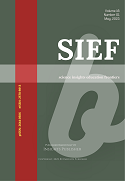The Application of the 5E Instructional Model in Chinese Basic Education
##plugins.themes.bootstrap3.article.main##
##plugins.themes.bootstrap3.article.sidebar##
Abstract
The 5E instructional framework is a pedagogical approach that consists of five distinct phases, namely engagement, exploration, explanation, elaboration, and evaluation, which together form a comprehensive learning cycle. Each stage denotes a crucial instructional process. The objective of the model is to facilitate the development of a robust knowledge base among students through their active engagement. This paper provides an overview of the historical development of the 5E Model and evaluates its application in the context of Chinese elementary education. The aim is to offer valuable insights into this educational strategy for teachers in the Chinese basic education system.
Downloads
##plugins.themes.bootstrap3.article.details##
5E Instructional Model, Learning Cycle, Basic Education, Classroom Instruction
Bybee, R. W., Taylor, J. A., Gardner, A., Van Scotter, P., Powell, J. C., Westbrook, A., & Landes, N. (2006). The BSCS 5E Instructional Model: Origins, Effectiveness, and Applications. Colorado Springs BSCS. Available at: http://science.education.nih.gov/houseofreps.nsf/b82d55fa138783c2852572c9004f5566/$FILE/Appendix%20D.pdf
Cao, M. D. (2022) The application of 5E instructional model in the junior secondary physics class: Using the “Reflection of Light” teaching as an example. Physics Teaching, 44(8):29-32.
Dai, M., & Yao, B. J. (2008). The application of the 5E learning cycle in biology instruction. Biology Teaching, 2008(7):18-19.
Deng, Q. P., & Liu, E. S. (2011). Applying the 5E instructional model to the teaching design of “Refusing Under-age Drinking.” Bulletin of Biology, 46(1):28-30. DOI: https://doi.org/10.3969/j.issn.0006-3193.2011.01.011
Duran, E., Duran, L., Haney, J., & Scheuermann, A. (2011). A learning cycle for all students. The Science Teacher, 78(3);56-60.
Available at: http://people.uncw.edu/kubaskod/sec_406_506/classes/class_6_planning/learning_cycle.pdf
Eisenkraft, A. (2003). Expanding the 5E model. The Science Teacher, 70(6):56-59.
Ergin, I. (2012). Constructivist approach based 5E model and usability instructional physics. Latin-American Journal of Physics Education, 6(1);14-20.
Fu, X.,, & Yang, W. Y. (2014). Applying the 5E instructional model to the teaching design of “Cell Differentiation.” Bulletin of Biology, 49(7):29-31.
Fu, Y. D., & Chen, L. W. (2022). The teaching design for senior secondary physics based on the 5E instructional mode: A lesson study of the “Surface Tension of Liquid” teaching. Physics Teachers, 43(1):6-11.
Guan, B. D. (2021). The classroom teaching design for Senior secondary physics based on the 5E instructional model. Teaching Reference of Middle School Physics, 2021(21):50-51.
Jun, W. H., Lee, E. J., Park, H. J., Chang, A. K., & Kim, M. J. (2013). Use of the 5E learning cycle model combined with problem-based learning for a fundamentals of nursing course. Journal of Nursing Education, 52(12):681-689. DOI: https://doi.org/10.3928/01484834-20131121-03
Kong, Y. (2012). Practice and exploration of the 5E learning cycle in senior secondary chemistry teaching. Chemistry Teaching and Learning, 2012(3):43-45+35
Lin, F. Q., & Yao, D. W. (2007). An evaluation of 5E instruction, a constructivist teaching model: A lesson study of “Free Fall.” Educational Practice and Research (Secondary School Edition), 2007(5):51-53.
Liu, X. R. (2014). The framework and characteristics of the U.S.’s New Generation Science Standards. Studies in Foreign Education, 2014(5):115-122.
Luo, X. F. (2015). The teaching design of senior secondary biology experiments based on the 5E instructional model. Biology Teaching, 40(11):45-47.
Ma, W. K. (2002). The 5E instructional model in American BSCS textbooks. Primary and Secondary Schooling Abroad, 2002(4):39-40. DOI: https://doi.org/10.3969/j.issn.1007-8495.2002.04.007
Marshall, J. C., Horton, B., & Smart, J. (2009). 4E× 2 instructional model: Uniting three learning constructs to improve praxis in science and mathematics classrooms. Journal of Science Teacher Education, 20(6):501-516. DOI: http://dx.doi.org/10.1007/s10972-008-9114-7
National Academies of Sciences, Engineering, and Medicine. (2013). Next Generation Science Standards: For States, By States. Washington, DC: The National Academies Press. DOI: https://doi.org/10.17226/18290
Sickel, A. J., & Friedrichsen, P. J. (2015). Beliefs, practical knowledge, and context: A longitudinal study of a beginning biology teacher's 5E unit. School Science and Mathematics, 115(2):75-87. DOI: https://doi.org/doi:10.1111/ssm.12102
Tao, Y. J. (2017). The application of the 5E instructional model to the teaching of core concepts of secondary biology: An analysis of the instruction of “DNA Replication.” Middle School Biology, 2017(12):27-30.
Wang, J., & Li, X. J. (2012). The components of the 5E instructional model and their implications for science education in China. Bulletin of Biology, 47(3):39-42.
Wang, T, Dai, W. Y., & Chen, Q. Y. (2019). The Application of the 5E instructional model to geographic experiment teaching: Using the simulative experiment of river topography as an example. Geography Teaching, 2019(20):4-7.
Wu, C. J., & Zhang, M. (2010). The components, examples, and essential characteristics of the 5E instructional model in American biology education. Curriculum, Teaching Material and Method, 2010(6):108-112. DOI: https://doi.org/10.19877/j.cnki.kcjcjf.2010.06.024
Wu, X. L., & Liu, J. J. (2012). The Application of the 5E learning cycle in junior secondary chemistry teaching. Chinese Journal of Chemical Education, 33(5):28-30. DOI: https://doi.org/10.3969/j.issn.1003-3807.2012.05.009
Xiong, T. Z. (2012). Teaching Design for the instruction of “Multimeters” based on the 5E instructional model. Sciences and Wealth, 2012(2):2.
Xue, X. Y., Cai, C., & Ma, L. F. (2010). Educational Theories and Strategies. Zhenjiang: Jiangsu University Press. 2010.
Yadigaroglu, M., & Demircioglu, G. (2012). The effect of activities based on 5E model on grade 10 students’ understanding of the gas concept. Procedia-Social and Behavioral Sciences, 47:634-637. DOI: https://doi.org/10.1016/j.sbspro.2012.06.709
Yan, L. M. (2022). The classroom teaching design for senior secondary physics based on the 5E instructional model. Asia-Pacific Education, 2022(14):4-6.
Yuan, T. Z. (2022). The teaching of Junior secondary mathematics concepts based on the 5E instructional model: Citing the lesson on “Variables and Functions” as a case study. Teacher Education Forum, 35(12):58-60.
Yuan, W. X. (2004). The 5E instructional model and its application in biology education. Biology Teaching, 2004(5):10-11.

This work is licensed under a Creative Commons Attribution-NonCommercial 4.0 International License.

